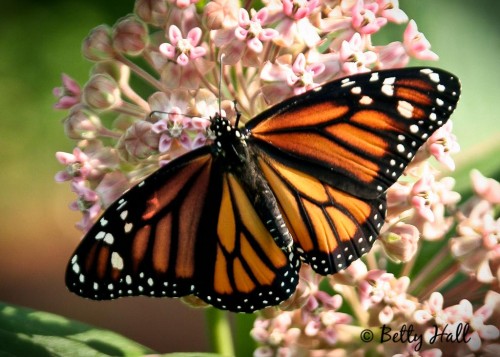
My introduction to monarchs. I became fascinated with butterflies about 7 years ago when I first saw a monarch laying eggs on some common milkweed (Asclepias syriaca) in our backyard. I watched the eggs hatch into caterpillars and then noticed that the caterpillars were disappearing. I took some of them inside so they would be safe from predators and watched and photographed them as they grew, made chrysalises, and finally emerged as butterflies. It was a wonderful experience, and as a result I’ve become more aware and appreciative of monarchs and all butterflies.
The monarchs’ life story. I’m especially intrigued by monarchs because of their unique migration. Monarchs that live east of the Rockies fly 1,200-2,800 miles to a specific area in Mexico for the winter, then return to the southern United States in the spring. They find a milkweed plant, lay their eggs and die. The next generations repeat the process – fly north, find milkweed, lay eggs and die – until some of them reach southern Canada. The last generation of the summer is called a “super generation.” They live up to seven months and make the long journey to Mexico. The ones that survive the winter will return to the southern U.S. to once again begin the cycle.
Monarchs need milkweeds. Milkweeds are the only plants the caterpillars can eat and the only plants on which the females will lay their eggs. Monarchs in the U.S. are in serious decline because of loss of habitat due to spraying of herbicides and development, both of which destroy milkweeds.
Scary statistics. In 1976 the overwintering monarchs in Mexico covered 50 acres; in 2012 they covered less than 3. Their current population is 1/15th of what it was in 1977. And there was a 59% decrease in 2012 compared with 2011.
The good news is that we can help! Monarch Watch sponsors a Monarch Waystation program, challenging all of us to create habitat by planting milkweeds and nectar plants in our yards. Local Kentucky native milkweeds include common milkweed (Asclepias syriaca), swamp milkweed (A. incarnata), butterfly milkweed (A. tuberosa) and purple milkweed (A. purpurascens). And if you create habitat for monarchs, you will also attract other butterflies and pollinators.
If you are interested in further information, the following resources on this website may be helpful:
- 5 steps to create a Monarch Waystation (300KB PDF) The basic requirements for a certified Monarch Waystation. Requirements are also available at Monarch Watch.
- 25 favorite KY native plants – a list of some of my favorite plants that attract butterflies, other pollinators, and birds.
- Monarch Magic – I created this picture book to share my interest in Monarchs with young children. You can preview it and buy a copy on Blurb, (paperback or hardback) or contact me.
- Monarch Waystations – this article by Susan Jonas is a great summary of why and how to help Monarchs.
Here are some additional resources:
- Lexington Wild Ones (or on Facebook). Wild Ones is a national organization that advocates landscaping with native plants. The Lexington chapter promotes the planting of milkweeds and creation of Monarch Waystations. Check for information about monthly meetings. Visitors are welcome.
- Garden Club of Kentucky, is working with Wild Ones to increase planting of milkweeds and Monarch Waystations throughout the state.
- Monarch Watch (or on Facebook). A nonprofit educational outreach program based at the University of Kansas that focuses on the monarch butterfly, its habitat, and its spectacular fall migration.
- Journey North. Track the monarchs’ yearly progress and report monarch sightings.
- Monarch Joint Venture is a partnership of federal and state agencies, non-governmental organizations, and academic programs that are working together to protect the monarch migration across the lower 48 United States.
- North American Butterfly Association (NABA) is a membership-based nonprofit organization working to increase public enjoyment and conservation of butterflies. The website includes butterfly gardening information, a way to track butterflies you’ve seen, and photography tips.
- Pollinator Partnership is working to protect pollinators and their habitats with projects in the United States and globally.
- The Xerces Society is a nonprofit organization that protects wildlife through the conservation of invertebrates and their habitat.
-
“Life Cycles of Butterflies,” by Kentucky authors Judy Burris and Wayne Richards. This book is a must for any serious butterfly gardener, and a great resource for those who want to identify common Kentucky butterflies and learn more about their life cycles and host plants.
If we all help a little, we can make a difference!
